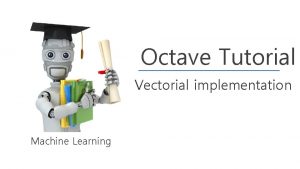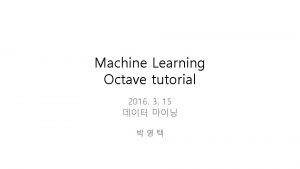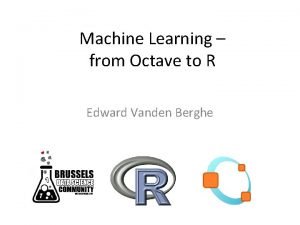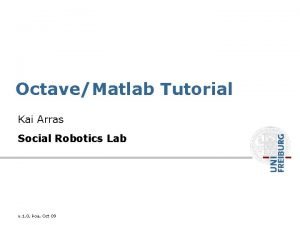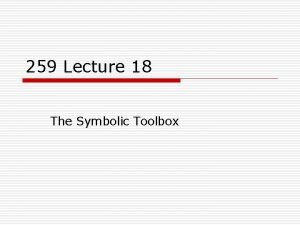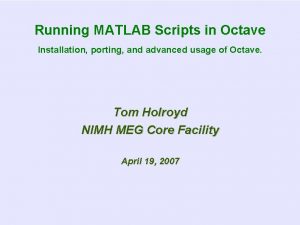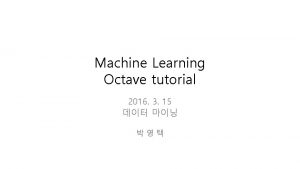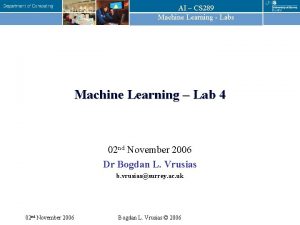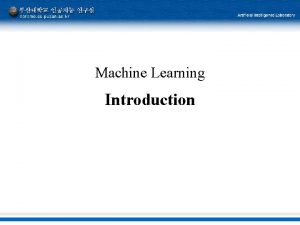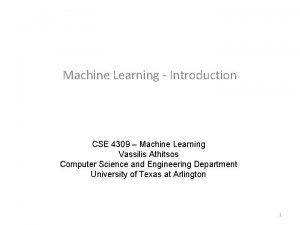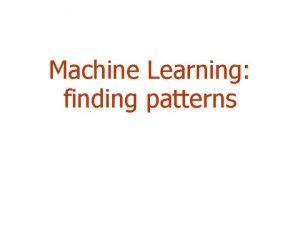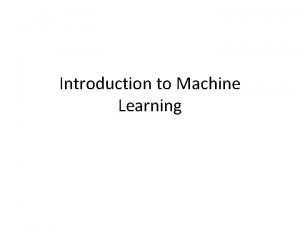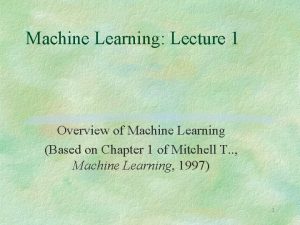Machine Learning Octave tutorial 2016 3 15 Octave




![Basic operations >> v = [1: 0. 1: 2] % from 1 to 2, Basic operations >> v = [1: 0. 1: 2] % from 1 to 2,](https://slidetodoc.com/presentation_image_h/df09df9294d221adb4e3fa9c815206a5/image-5.jpg)



![Moving data around %% dimensions >> A = [1 2; 3 4; 5 6] Moving data around %% dimensions >> A = [1 2; 3 4; 5 6]](https://slidetodoc.com/presentation_image_h/df09df9294d221adb4e3fa9c815206a5/image-9.jpg)


![Moving data around >> A(: , 2) = [10; 11; 12] % change second Moving data around >> A(: , 2) = [10; 11; 12] % change second](https://slidetodoc.com/presentation_image_h/df09df9294d221adb4e3fa9c815206a5/image-12.jpg)
![Moving data around >> A = [1 2; 3 4; 5 6] >> B Moving data around >> A = [1 2; 3 4; 5 6] >> B](https://slidetodoc.com/presentation_image_h/df09df9294d221adb4e3fa9c815206a5/image-13.jpg)

![Computing on data >> A = [1 2; 3 4; 5 6] >> A Computing on data >> A = [1 2; 3 4; 5 6] >> A](https://slidetodoc.com/presentation_image_h/df09df9294d221adb4e3fa9c815206a5/image-15.jpg)
![Computing on data >> V = [1; 2; 3] >> exp(V) % e^4 >> Computing on data >> V = [1; 2; 3] >> exp(V) % e^4 >>](https://slidetodoc.com/presentation_image_h/df09df9294d221adb4e3fa9c815206a5/image-16.jpg)

![Computing on data >> a = [1 15 2 0. 5]; >> sum(a) >> Computing on data >> a = [1 15 2 0. 5]; >> sum(a) >>](https://slidetodoc.com/presentation_image_h/df09df9294d221adb4e3fa9c815206a5/image-18.jpg)


![Plotting data >> t = [0: 0. 01: 0. 98]; >> y 1 = Plotting data >> t = [0: 0. 01: 0. 98]; >> y 1 =](https://slidetodoc.com/presentation_image_h/df09df9294d221adb4e3fa9c815206a5/image-21.jpg)





![Control statements : function >> function [y 1, y 2] = square. And. Cube. Control statements : function >> function [y 1, y 2] = square. And. Cube.](https://slidetodoc.com/presentation_image_h/df09df9294d221adb4e3fa9c815206a5/image-27.jpg)





- Slides: 32

Machine Learning Octave tutorial 2016. 3. 15 데이터 마이닝 박영택

Octave Tutorial Basic operations Machine Learning

Basic operations %% >> >> >> elementary operations 5 + 6 % 11 3 - 2 % 1 5 * 8 % 40 1 / 2 % 0. 50000 2 ^ 6 % 64 1 == 2 % false 1 ~= 2 % true. note, not "!=" 1 && 0 % 0 : AND 1 || 0 % 1 : OR xor(1, 0) % 1 %% >> >> >> variable assignment a = 3; % semicolon suppresses output b = 'hi'; c = (3 >= 1); % Displaying them: >> a = pi % 3. 1416 >> disp(sprintf('2 decimals: %0. 2 f', a)) % 2 decimals: 3. 14 >> disp(sprintf('6 decimals: %0. 6 f', a)) % 6 decimals: 3. 141593 >> format long >> a % 3. 14159265358979 >> format short >> a % 3. 1416

Basic operations %% vectors and matrices >> A = [1 2; 3 4; 5 6] >> v = [1 2 3] % row vector >> v = [1; 2; 3] % column vector
![Basic operations v 1 0 1 2 from 1 to 2 Basic operations >> v = [1: 0. 1: 2] % from 1 to 2,](https://slidetodoc.com/presentation_image_h/df09df9294d221adb4e3fa9c815206a5/image-5.jpg)
Basic operations >> v = [1: 0. 1: 2] % from 1 to 2, with step size of 0. 1. Useful for plot axes >> v = 1: 6 % from 1 to 6, assumes step size of 1 >> C = 2*ones(2, 3) % same as C = [2 2 2; 2 2 2]

Basic operations >> w = zeros(1, 3) >> w = rand(1, 3) % drawn from a uniform distribution >> w = randn(1, 3) % drawn from a normal distribution (mean=0, var=1) >> w = -6 + sqrt(10)*(randn(1, 10000)) % (mean = 1, var = 2) . . . until 10, 000

Basic operations >> hist(w) % help function >>help rand >> help eye >> I = eye(4) % 4 x 4 identity matrix

Octave Tutorial Moving data around Machine Learning
![Moving data around dimensions A 1 2 3 4 5 6 Moving data around %% dimensions >> A = [1 2; 3 4; 5 6]](https://slidetodoc.com/presentation_image_h/df09df9294d221adb4e3fa9c815206a5/image-9.jpg)
Moving data around %% dimensions >> A = [1 2; 3 4; 5 6] >> sz = size(A) >> size(A, 1) % number of rows >> size(A, 2) % number of cols >> length(sz) % size of longest dimension

Moving data around %% >> >> >> loading data pwd % show current directory (current path) cd 'C: UsersangOctave files' % change directory ls % list files in current directory load q 1 y. dat % same with load(‘q 1 y. dat’) who % list variables in workspace whos % list variables in workspace (detailed view) >> clear sz % clear w/ no argt clears all >> v = q 1 y(1: 10); >> save hello v; % save variable v into file hello. mat >> save hello. txt v -ascii; % save as ascii % fopen, fread, fprintf, fscanf also work [[not needed in class]]

Moving data around %% indexing >> A(3, 2) % indexing is (row, col) >> A(2, : ) % 3 4 : get the 2 nd row. % ": " means every element along that dimension >> A(: , 2) % get the 2 nd col >> A([1 3], : )
![Moving data around A 2 10 11 12 change second Moving data around >> A(: , 2) = [10; 11; 12] % change second](https://slidetodoc.com/presentation_image_h/df09df9294d221adb4e3fa9c815206a5/image-12.jpg)
Moving data around >> A(: , 2) = [10; 11; 12] % change second column >> A = [A, [100; 101; 102]] % append column vec >> A(: ) % Select all elements as a column vector.
![Moving data around A 1 2 3 4 5 6 B Moving data around >> A = [1 2; 3 4; 5 6] >> B](https://slidetodoc.com/presentation_image_h/df09df9294d221adb4e3fa9c815206a5/image-13.jpg)
Moving data around >> A = [1 2; 3 4; 5 6] >> B = [11 12; 13 14; 15 16] % same dims as A >> [A B] >> [A; B]

Octave Tutorial Computing on data Machine Learning
![Computing on data A 1 2 3 4 5 6 A Computing on data >> A = [1 2; 3 4; 5 6] >> A](https://slidetodoc.com/presentation_image_h/df09df9294d221adb4e3fa9c815206a5/image-15.jpg)
Computing on data >> A = [1 2; 3 4; 5 6] >> A * C % matrix multiplication >> B = [11 12; 13 14; 15 16] >> A. * B % element-wise multiplcation % A. * C or A * B gives error - wrong dimensions >> C = [1 1; 2 2] >> A. ^ 2
![Computing on data V 1 2 3 expV e4 Computing on data >> V = [1; 2; 3] >> exp(V) % e^4 >>](https://slidetodoc.com/presentation_image_h/df09df9294d221adb4e3fa9c815206a5/image-16.jpg)
Computing on data >> V = [1; 2; 3] >> exp(V) % e^4 >> 1. / V >> -V % -1*v >> log(V) % functions like this operate element-wise on vecs or matrices >> abs(V) >> V + ones(length(V), 1) % v + 1 % same >> A' % matrix transpose if A is * A = (A’)’

Computing on data % max (or min) >> a = [1 15 2 0. 5] >> val = max(a) >> [r, c] = find(A>=7) >> [val, ind] = max(a) % find >> a < 3 % true or false each index * position : (1, 1), (3, 2), (2, 3) >> find(a < 3) % true index >> A = magic(3)
![Computing on data a 1 15 2 0 5 suma Computing on data >> a = [1 15 2 0. 5]; >> sum(a) >>](https://slidetodoc.com/presentation_image_h/df09df9294d221adb4e3fa9c815206a5/image-18.jpg)
Computing on data >> a = [1 15 2 0. 5]; >> sum(a) >> prod(a) % product >> max(A, [], 1) % max of column and same with max(A) >> floor(a) % down decimal or ceil(a) is up >> min(A, [], 2) % min of row >> max(rand(3), rand(3))

Computing on data >> A = magic(9) >> eye(9) >> sum( A. * flipud(eye(9)) )) % Matrix inverse (pseudo-inverse) >> pinv(A) % inv(A'*A)*A' >> sum( A. * eye(9) )) >> sum(A, 1) >> flipud(eye(9)) >> sum(A, 2)

Octave Tutorial Plotting data Machine Learning
![Plotting data t 0 0 01 0 98 y 1 Plotting data >> t = [0: 0. 01: 0. 98]; >> y 1 =](https://slidetodoc.com/presentation_image_h/df09df9294d221adb4e3fa9c815206a5/image-21.jpg)
Plotting data >> t = [0: 0. 01: 0. 98]; >> y 1 = sin(2 * pi * 4 * t); >> plot(t, y 1); >> y 2 = cos(2 * pi * 4 * t); >> hold on; % for drawing same canvas >> plot(t, y 2, ‘r’); % ‘r’ is red line

Plotting data >> >> y 2 = cos(2 * pi * 4 * t); hold on; % for drawing same canvas plot(t, y 2, ‘r’); % ‘r’ is red line xlabel(‘time’) ylabel(‘value’) legend(‘sin’, ‘cos’) title(‘my plot’) >> print –dpng ‘myplot. png’ % save image

Plotting data >> figure(1); plot(t, y 2); >> figure(2); plot(t, y 2); >> >> >> subplot(1, 2, 1); % Divides plot a 1 x 2 grid, access first element plot(t, y 1); subplot(1, 2, 2); % access second element plot(t, y 2); axis([0. 5 1 -1 1]) % [x. Start, x. End, y. Start, y. End]

Plotting data >> A = magic(5) >> imagesc(A), colorbar, colormap

Octave Tutorial Control statements: for, while, if statements Machine Learning

Control statements : if, for, while >> >> > > >> v = zeros(10, 1) for i = 1: 10, v(i) = 2^i; end; v >> indices = 1: 10; >> for i = indices, > disp(i); > end; >> i = 1; >> while i <= 5, > v(i) = 100; > i = i+1; > end; >> >> > > > >> i = 1; while true, v(i) = 999; i = i+1; if i == 6, break; end; v
![Control statements function function y 1 y 2 square And Cube Control statements : function >> function [y 1, y 2] = square. And. Cube.](https://slidetodoc.com/presentation_image_h/df09df9294d221adb4e3fa9c815206a5/image-27.jpg)
Control statements : function >> function [y 1, y 2] = square. And. Cube. This. Number(x) > y 1 = x^2; > y 2 = x^3; > end; >> [q, w] = square. And. Cube. This. Number(3) % can have 2 return values q = 9 w = 27

Control statements : cost function J >> function J = cost. Function. J(X, y, theta) > % X is the “design matrix” containing our training examples. > % y is the class labels. > > m = size(X, 1); % number of training examples. > predictions = X * theta; % predictions of hypothesis on all m examples > sqr. Errors = (prediction – y). ^ 2; > J = 1 / (2*m) * sum(sqr. Errors); > > end; >> X = [1 1; 1 2]; >> y = [1; 2; 3]; >> theta = [0; 1]; >> j = cost. Function. J(X, y, theta)

Octave Tutorial Vectorial implementation Machine Learning

Vectorial implementation . . . Vectorization!

Vectorial implementation. . . Vectorization!

Vectorial implementation # Octave code
 Octave machine learning
Octave machine learning Octave tutorial machine learning
Octave tutorial machine learning Octave vs r for machine learning
Octave vs r for machine learning Octave/matlab tutorial
Octave/matlab tutorial Weka machine learning tutorial
Weka machine learning tutorial Concept learning task in machine learning
Concept learning task in machine learning Analytical learning in machine learning
Analytical learning in machine learning Pac learning model in machine learning
Pac learning model in machine learning Machine learning t mitchell
Machine learning t mitchell Inductive and analytical learning
Inductive and analytical learning Inductive analytical approach to learning
Inductive analytical approach to learning Instance based learning in machine learning
Instance based learning in machine learning Inductive learning machine learning
Inductive learning machine learning First order rule learning in machine learning
First order rule learning in machine learning Eager learning examples
Eager learning examples Cmu machine learning
Cmu machine learning Cuadro comparativo e-learning b-learning m-learning
Cuadro comparativo e-learning b-learning m-learning Algebra 1 sol standards
Algebra 1 sol standards 2016 mathematics standards of learning
2016 mathematics standards of learning Mgmt+8
Mgmt+8 Turing machine simulator tutorial
Turing machine simulator tutorial Finite state machine vending machine example
Finite state machine vending machine example Moore machine and mealy machine
Moore machine and mealy machine Moore machine to mealy machine
Moore machine to mealy machine Chapter 10 energy, work and simple machines answer key
Chapter 10 energy, work and simple machines answer key Octave rhyme scheme
Octave rhyme scheme Liambic
Liambic Figurative language
Figurative language Octave symbolic math
Octave symbolic math Octave definition poetry
Octave definition poetry Octave risk management framework
Octave risk management framework Run matlab script in octave
Run matlab script in octave Octave parfor
Octave parfor
